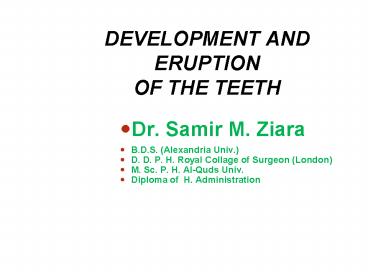DEVELOPMENT AND ERUPTION OF THE TEETH PowerPoint PPT Presentation
1 / 20
Title: DEVELOPMENT AND ERUPTION OF THE TEETH
1
DEVELOPMENT AND ERUPTIONOF THE TEETH
- Dr. Samir M. Ziara
- B.D.S. (Alexandria Univ.)
- D. D. P. H. Royal Collage of Surgeon (London)
- M. Sc. P. H. Al-Quds Univ.
- Diploma of H. Administration
2
Two years old
3
Five years
4
8 years
5
8 YEARS
6
DEVELOPMENT AND ERUPTION OF THE TEETH
- Historically the term eruption has been used to
denote emergence of the tooth through the gingiva
although it denotes more completely continuous
tooth movement from the dental bud to occlusal
contact . - However, the terms eruption and emergence will
be used here at this time in such a way as to
avoid any confusion between historical use of
emption and its more recent expanded meaning.
7
- Dental age has been assessed on the basis of the
number of teeth at each chronological age or on
stages of the formation of crowns and roots of
the teeth. - Dental age during the mixed dentition period may
be assessed on the basis of which teeth have
erupted, the amount of resorption of the roots of
primary teeth, and the amount of development of
the permanent teeth.
8
- Calcification or mineralization (most often
visualized radiographically) of the organic
matrix of a tooth, root formation, and tooth
eruption are important indicators of dental age. - Dental age can reflect an assessment of
physiologic age comparable to age based on
skeletal development, weight. or height.
9
- However, when forming, the crowns and roots of
the teeth appear to be the tissues least affected
by environmental influences (nutrition,
endocrinopathies. etc.), and dentition may be
considered to be the single best physiological
indicator of chronological age in juveniles
10
Dental development may be based also on the
emergence (eruption) of the teeth however,
because caries, tooth loss. and severe
malnutrition may influence the emergence of teeth
through the gingiva, chronologies of the eruption
of teeth are less satisfactory for dental age
assessment than those based on tooth formation.
11
In addition, tooth formation may be divided
appropriately into a number of stages that cover
continuously the development of teeth, in
contrast to the single episode of tooth eruption.
12
The importance of the emergence of the teeth to
the development of oral motor behavior is
frequently overlooked, no doubt partly as a
result of the paucity of information available.
13
However, the appearance of the teeth in the mouth
at a strategic time in the maturation of the
infant's nervous system and its interface with
the external environment must have a profound
effect on the neurobehavioral mechanisms
underlying the infants development and learning
of feeding behavior, particularly the acquisition
of masticatory skills.
14
TOOTH FORMATION STANDARDS
- Events in the formation of human dentition are
based primarily on data from studies of dissected
prenatal anatomic material and from radiographic
imaging of the teeth of the same subjects over
time (longitudinal data) or of different subjects
of different ages seen once (cross-sectional
data).
15
(No Transcript)
16
(No Transcript)
17
- From these kinds of studies both descriptive
information and chronological data may be
obtained. - To assemble a complete description or chronology
of human tooth formation it would seem necessary
to use data based on more than one source and
methodology. - However, it is not easy to define ideal tooth
formation standards from studies based on
different variables and many different
statistical methods.
18
- Subjects surveyed in most studies of dental
development are essentially of European
derivation, and population differences can only
be established by studies that share methodology
and information on tooth formation in
nonwhite/non-European-derived populations
19
(No Transcript)
20
SCHOUR AND MASSIER (1940)

